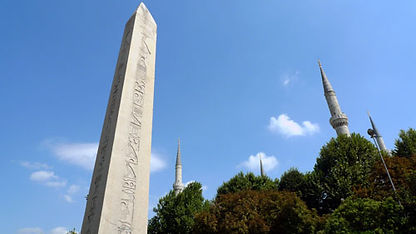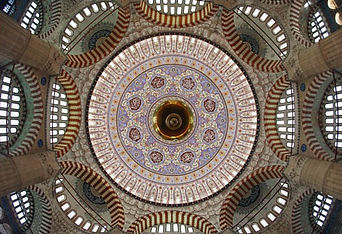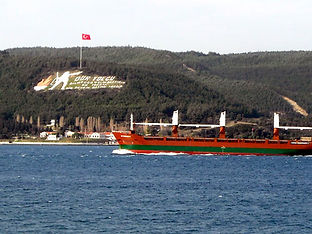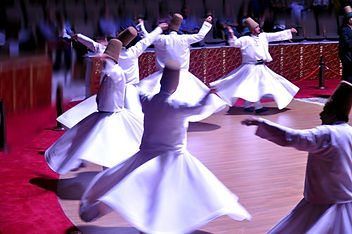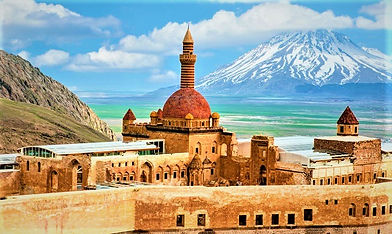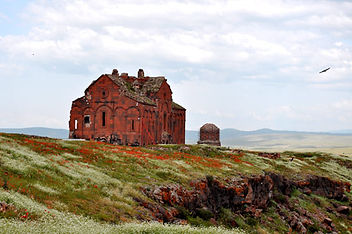
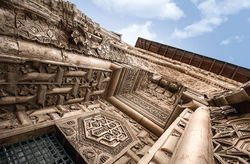 The Great Mosque and Hospital complex in Divrigi. |  The Meric Bridge in Edirne, ancient Hadrianapolis. |  The Tomb of Celalettin Rumi Mevlana, Konya. Founder of the Sufi Dervish Order, the Whirling Dervishes. |  The unique 'Frozen Waterfall' of Pamukkale |  The baroque-rococo palace of Ishakpasa on the Iranian border under Mt Ararat. |
|---|---|---|---|---|
 One of the largest crater lakes in the world, Lake Nemrut. |  The steep theatre perched on the acropolis of Pergamon. |  The basalt built Ulucami, the Great Mosque of Diyarbakır. |  Gobekli tepe Turkey's Newest UNESCO site |  The Oldest Mosque in Anatolia, in Ani, the unforgettable Armenian city. |
 The Harpy Tomb in Xanthos (C) Curt Bidinger |  The Sphinx Gate at Hittite capital Hattutas. |  An archetypal Ottoman trading town on the caravan route. Visit the different quarters run by the different religious communities. |  The Mysterious Stone Heads at the Summit of Mt. Nemrut |  The Neolithic site of Catalhoyuk is thought to be the world's oldest settlement. |
 Istanbul Sultan Ahmet Mosque. The famed Blue Mosque, named for the blue Iznik tiles inside |  The Theodosian walls of Constantinople. The massive land walls stretch for 6.5km. |  The Library of Celsus, Ephesus |  The strangely eroded tufa columns with basalt caps, one of the symbols of Cappadocia. |  The golden mosaics of the Byzantine dome of the Church of the Chora. Some of the finest Byzantine decorations anywhere. |
 The fine theatre of Hierapolis, part of the UNESCO world heritage site. |  The horse that was used in the film, now in Canakkale centre |  The Propylon of Aphrodisias, recently awarded UNESCO world Heritage Site status |
Turkey's UNESCO World Heritage Sites.
The Complete Tour.

Turkey. Anatolia. The Bridge. The Connection. The Link. The Gateway between East and West. Bearing traces of all the civilisations that have been nurtured on this most varied and hospitable of lands. Providing a homeland to Hittites, Sumerians, Lydians, Trojans, Ionians, Persians, Urartians, Hellenes, Lycians, Galatians, Phrygians, Romans, Armenians, Crusaders, Byzantines, Seljuks and the Ottomans. No land can claim a richer cultural heritage.
Visiting all 17 sites inscribed on the UNESCO World Heritage list and 5 on the tentative list, this private journey is a unique and unforgettable journey. Using expert local guides and public transport whenever practical, this tour provides a deep and privileged insight into this richest of lands.
Day 1. Arrive to Istanbul. Fabled capital of the Roman, Byzantine and Ottoman Empires. Keystone of the World. Transfer to Old Town.
You will be met at Ataturk Airport by your private driver and whisked through the Theodosian walls which made this, the world's largest city, virtually indomitable for 1000 years. Arriving to the Turkoman Boutique Hotel, just above the ancient Hippodrome, the site of many a Byzantine intrigue and occasional bloody repression of an uprising. You may have time for an atmospheric stroll around the monuments that Constantine the Great brought from the far reaches of his empire to adorn his new capital, christened the New-Rome, but better known as Constantinople - the City of Constantine. The endless cultural and historical depth of this city make it the archetypal UNESCO World Heritage Site and the natural gateway to our Turkish Cultural Odyssey. See http://whc.unesco.org/en/list/356
Day 2. Tour the Hippodrome, Hagia Sophia, Topkapi Palace and The Basilica Cistern.
Meeting your Western Turkey guide, you will first tour the sites of the Hippodrome. Centre of this huge city's social life, the Hippodrome was adorned with the finest art works from the four corners of the Roman Empire, as Constantine wanted to make his new capital the focal point of the world. The centuries have not been kind to the Hippodrome however, the only remaining artworks are the bronze Serpentine Column, the Thutmose III Obelisk from Egypt, and the Porphyrogenitus Column. Next, we visit famous Blue Mosque, though not quite so ancient, it was built during the reign of Sultan Ahmet to rival the massive Hagia Sophia Cathedral which we will visit next. The present building was built in the 6th Century by Justinian the Great, just after he put down the Nika riots with the loss of 30,000 lives. This great Christian church was the largest building in the world for 1000 years until Seville Cathedral was built. We will then visit the Topkapi Palace, the understated but sumptuous home of generations of Ottoman Sultans. The palace contains many treasures and holy relics. We finish the day visiting the unique Basilica Cistern, an underground sea of classical columns, built to hold water for the city when the aqueducts failed.
Day 3. Tour the Theodosian Walls, the Church of Chora, the Valens Aqueduct and cruise the legendary Bosphorus.
By taxi, we go the edge of the old city to see the walls which protected this city for over 1000 years; only defeated by treachery in 1203 (Fourth Crusade) and by Mehmet the Conqueror's Ottoman cannons in year 1453. To this day the walls are a magnificent sight. The inner wall being 12 metres high, itself defended by an outer wall and a moat 10 metres wide. From the walls, we walk to the Church of the Chora. This late Byzantine church is stunningly decorated with frescoes and golden mosaics, due to post-dating the Iconoclastic period, it has survived to this day, as probably one of the finest examples of Byzantine art. You may also want to visit the nearby Palace of Porphyrogenitus, the only remaining Byzantine Emperor's palace built for the man who was 'born into the purple', a reference to the emperors' robes. From here you will take a bus down past the Valens Aqueduct, to the Galata Docks and join a cruise up the Bosphorus, where Jason and the Argonauts navigated the clashing rocks, now lined with Ottoman mansions.
Day 4. Edirne. Hadrianapolis - The Western Gate. Visit the bridges and the Selimiye Mosque complex - magnum opus of Mimar Sinan
Your guide meets you at the hotel and you go to the main bus station of Istanbul, an impressive sight by itself! We take a comfortable intercity but to Edirne, Turkey's western border city, at the point where Turkey meets Bulgaria and Greece. Edirne was always an important city, its bridges providing the only way to the West, the city has a long history. Originally founded by the son of Agamemnon, the city was re-founded in Roman times and named Hadrianapolis, after the famous emperor. The city became the third Ottoman capital, after Bursa and before Istanbul. During Ottoman times the genius Armenian architect Sinan was charged to build a mosque complex in honour of Selim the Grim, Father of Suleyman the Magnificent. Sinan considered this mosque to be his finest work, the light and balance of the dome is breathtaking. He also designed one of the bridges that spanned the two rivers here. We will also visit the Grand Synagogue, home of the once thriving Jewish merchant community, and the famous bridge spanning the Meric river. See http://whc.unesco.org/en/list/1366
Day 5. Fast Ferry to Mudanya, Bus to Bursa and Cumalikizik.
Turning our backs upon the European continent, we cross the Sea of Marmara to Bursa, the great city founded at the base of Mysian Mt. Olympus, known now as Ulu Dag, complete with ski centres. Bursa was founded as Prusa named after the Bithynian King Prusias. A centre of the Byzantine silk trade, Bursa flourished especially after being conquered by the Ottomans in 1335. Becoming capital of the Ottoman Empire Bursa grew even more and was furnished with some of the fine buildings that we now see. The famous Ulu Cami ( Great Mosque) has a wide and subdued interior, designed for reflective prayer, as opposed the later Ottoman mosques which were built higher to show the glory of God. You will visit the tomb of Osman Gazi, father of the Ottoman line, Irgandi Bridge, and the Green Mosque. Taking a bus to the Ottoman 'Vafk' model village of Cumalikizik you will see a planned village of the time, designed to increase agricultural produce and social welfare. Overnight in Sukran Hotel Bursa. See:http://whc.unesco.org/en/list/1452
Day 6. Travel to Canakkale. Optional crossing of the Dardanelles - Hellespont, optional visit to Gallipoli battlefields.
Getting the intercity bus down the southern shores of the Sea of Marmara, we arrive mid-morning to Canakkale. You have the opportunity to relax in this pleasant university town watching the shipping pass the famous straits that Lord Byron swam across, or you may wish to cross to on the frequent ferries, to visit the sites of the Gallipoli battles, which were of such importance to modern Turkish history as well as to ANZAC consciousness. You can join an organised tour of the sites depending on your particular interests and background. See: http://whc.unesco.org/en/tentativelists/5911/ Overnight in Anzac Hotel. We recommend that you dine in one of the famous fish restaurants on the waterfront.
Day 7. Take local bus to Troy. Visit the site of Homer's Iliad. Travel on to Bergama.
Probably one of the most famous cities in history, Troy ( Illium, Troya, Wilusa) has the ultimate in strategic positions, controlling trade between the Mediterranean and Black Sea, on its hill beside the Scamander estuary. We are all aware of the legendary war which happened here between famous names like Agamemnon, Menelaus, Achilles, Hector, Paris, Trojan King Priam and the Amazons. Helen of Troy may have been the reason, but trade in the Black Sea's tin resources (needed to make Bronze), and Achaean Greek expansionism may have been the real reason. We will see the many layers of this historic city brought to life. We then take the bus around the coast to Bergama, site of Pergamon. Overnight in boutique Sanart Guest House. See: http://whc.unesco.org/en/list/849
Day 8. Tour Pergamon, Capital of Roman Asia Province. The great rival to Athens and Alexandria. Travel to Ephesus by train.
Once one of the largest cites of the world, one of the Seven Churches, the first province of Rome; Pergamon has an imposing acropolis reached by modern cable car. To give you some idea of the scale, this large city has 3 theatres, an amphitheatre and a stadium. You will visit the Acropolis first, marvel at the steeply raked theatre and the vaulted substructure required to support the Temple of Trajan above. The library here was a rival for Alexandria, so much so that papyrus exports from Egypt were banned, causing the Pergamese to create 'parchment', an animal skin based alternative. We descend to the 'Red Hall', an Egyptian temple of Isis, and then visit the 'Asklepion', an underground healing centre. We visit the small but fascinating museum before we get on the train to Selcuk, the modern town of Ephesus. Overnight Bella Hotel. See: http://whc.unesco.org/en/list/1457
Day 9. Tour Ephesus, its Terrace Houses, the site of the Temple of Artemis, the Basilica of St. John and Museum. Take train to Pamukkale.
The great harbour of Asia Minor, Ephesus has a multi-layered history, in fact the city moved several times. A centre of Mother-God worship, first the Anatolian Mother Goddess Cybele, The Greek Goddess Artemis and later the Virgin Mary were venerated here. Another of the Seven Churches, Ephesus had a large Jewish community who converted to Christianity early, encouraged by St John the Apostle who spent time here. Ephesus is very well preserved and excavated, the Roman civic design is clear. Walk from the council chamber all the way to the library, across to the theatre and down the 'Arcadian Way' to where the harbour was. After visiting the newly renovated museum and St. John Basilica we get on the train to Pamukkale / Heiropolis. Overnight in White Heaven Hotel. See: http://whc.unesco.org/en/list/1018
Day 10. Visit the natural wonder of Pamukkale, and the remarkable ancient spa city of Hierapolis. Visit Aphrodisias then travel on to Fethiye
A busy day today, we will start early and walk up through the travertine pools that make up the site of Pamukkale. This 'cotton castle' has no peer in the world, the heavily calcified water dries to create stunning white cascades. You can swim in the 'Cleopatra Pool' (extra charge) swimming round the ancient columns within it. Tour Hierapolis, a grand city whose economy was based on the treatments provided by the spa waters. See: http://whc.unesco.org/en/list/485 In the afternoon we will be taken by private car to Aphrodisias, the newest entrant to the UNESCO list. Aphrodisias is one of our favourite cities. Good quality local marble and schools of sculpture make this site a sensory treat for lovers of sculpture. The Temple of Aphrodite, and Temple of the Emperors (Sebasteion) are breathtaking. After visit, we take bus to Fethiye on the coast. Overnight Mara Hotel. See: http://whc.unesco.org/en/list/1519/
Day 11. Visit Telmessos, travel To Xanthos and Letoon. Visit Kas. Travel to Antalya
A long but rewarding day. In the morning you can visit the theatre and Amyntas Tomb of the Lycian city of Telmessos, now Fethiye. We then take the bus to the UNESCO site of Xanthos, the ancient capital of Lycia. This compact site has a tragic history of mass suicide in the face of defeat, carried out first upon defeat by the Persians in 540BC, and again in front of Brutus in 42BC. Xanthos was a centre of Lycian art, the Harpy Tomb and the Nereid Monument, which grace the British Museum were taken from here. We then go on to the Letoon, the religious centre of Lycia, by private car. It was believed that Leto was raped by Zeus, and thrown out of Olympos by Hera when her pregnancy was discovered. Leto gave birth to the divine twins Apollo and Artemis here, and the Lycians erected 3 temples to their honour. See: http://whc.unesco.org/en/list/484 From here we continue on to Kas, one of the nicest towns of the Turkish coast for some relaxation and perhaps a swim in the sea. Early evening we will take the bus to Antalya, and tram to the old town. Overnight in Atelya Art Hotel. Your Western Guide will depart from here.
Day 12. Free day to relax. You can swim, go shopping, have a Turkish Bath, visit the stunning museum or even visit Aspendos, on the UNESCO tentative list.
Based in the narrow streets of the old quarter of Antalya, named after Attalus, king of Pergamon. According to legend, he sent his men to find paradise on earth and build a city there. This clifftop site with waterfall, on the fertile Pamphylian plain surrounded by mountains, must have been close to paradise then. The walled, old city is a great place to spend the rest day. You may visit museums, relax in authentic Turkish Baths, have lunch and a swim in the sea, go for a boat-trip to the falls, or if you must see more remains, take a trip to the magnificent theatre of Aspendos See: http://whc.unesco.org/en/tentativelists/6036/ and the Hellenistic city of Perge. See: http://whc.unesco.org/en/tentativelists/5411/
Day 13 and 14. Travel to Beyşehir, meet your new guide. Visit the wooden Hypostile mosque at Beyşehir, Travel to Konya Visit the Tomb of the Mevlana, visit Catalhoyuk, Sultanhani Caravansaray and then to Cappadocia.
A private car will come to the hotel in the morning to take you to Antalya bus station. We provide you with seats at the front to give you the best of the panoramic views as you traverse the Taurus mountains into the central plateau. Your guide will meet you at the bus station and take you to visit Beautiful wooden Eşrefoglu Mosque, recently ascribed to UNESCO.https://whc.unesco.org/en/decisions/8427 Later continue on to Konya and visit the Mevlana tomb, the spiritual centre of Turkey and its Sufi traditions. See: http://whc.unesco.org/en/tentativelists/1404/ You will then drive to the site of Catalhoyuk, to the dawn of civilisation in this oldest of lands. You will see the mud brick houses of the hunter-gatherers who lived peacefully together here 9000 years ago. See: http://whc.unesco.org/en/list/1405 Next stop is the massive staging post on the Silk-Road Sultanhani. This massively strong hostelry was built and maintained during the Seljuk Turkish age to encourage trade, providing a safe place for the camel trains to stop overnight and sustenance for the merchants, crossing this barren landscape. See: http://whc.unesco.org/en/tentativelists/1403/ You will then continue to a cave hotel in Goreme, the heart of Cappadocia and base for the next 2 days.
Day 15. Walking tour of Cappadocia, the Goreme Painted Rock-Churches, Uchisar fortress and Love Valley.
A landscape completely different to anything you will have seen, the Cappadocian lands are formed from the soft Tufa rock made up from the ash of the two local volcanoes - Mt. Hasan and Mt. Argeus. The valleys of this area provided shelter to man for many centuries, the soft rock being easily carved into homes, churches, stores and even underground cities. After many days using vehicles, we will use our legs today to take us around the local sights of Cappadocia. First visit the Goreme Valley open air museum, with its famous painted churched to explore, then the trek up pigeon valley to the commanding views from atop the Uchisar fortress, carved into a natural stack of rock, then descend to the appropriately named Love Valley to see the finest fairy chimneys. Your guide will adjust the tour to suit your energy levels and can include Rose Valley and Cavusin churches. See: http://whc.unesco.org/en/list/357
Day 16. Travel to the mysterious Hittite capital Hattusha, their religious centre of Yazilikaya and the settlement of Alacahoyuk. Travel on to Safranbolu for overnight stay.
Visit the Hittites, once the most powerful civilisation in the world, Indo-European inventors of written records, great warriors who defeated Ramesses the Great of Egypt, concluding the first treaty known as the treaty of Kadesh. We travel by car north, deep into central Turkey, arriving in Boğazkale, the modern village of Hattutas. A compact museum here gives us a background to the huge site from where the Hittites ruled their massive empire from 1600BC. A short drive to Yazılıkaya, a temple carved into a natural cleft of rock, see the low relief of soldiers paying homage to their fearsome Gods. From here we drive to Alacahoyuk, an extremely well preserved Hittite walled town from 2500BC. See: http://whc.unesco.org/en/list/377 In the evening we continue our journey to Safranbolu. Overnight in Afifbey Konak Hotel.
Day 17 and 18. Tour Safranbolu, an archetypal Ottoman trading town. Drive to Ankara. Next day take high speed train to Gordion before board the Eastern Express.
Apart from its simple attractiveness as a town, Safranbolu is a fascinating look at Ottoman society. Safranbolu was a caravan trading town and you can track its development until the coming of the railway. The town is in three distinct districts, Cukur, the market area between two rivers, where merchants lived and worked. Kirankoy was where the non-Muslims lived and worked, the area has a distinctly European feel, the houses built of stone as opposed to the wooden houses of Cukur. The third area is Baglar, the vineyards. Here there are large houses set in gardens, the summer resort of the town and where the wealthy citizens lived. Safranbolu has many of the best examples of Ottoman domestic architecture well preserved away from the earthquake zones that blight many other Turkish cities. See: http://whc.unesco.org/en/list/614 In the afternoon we drive to Ankara, the country's modern capital. Overnight in Ankara. Next day take high speed train to Polatli and visit the site of Gordion hhere Alexander cut the knot. Visit the great tumulus of Midas https://whc.unesco.org/en/list/1669/ before getting on the iconic Eastern Express train this evening. Accommodation in comfortable 2 person sleeper cabin with sink, fridge and table. Enjoy dinner on the train as the train snakes along the banks of the Kizilirmak (Red River) before connecting to the Euphrates.
Day 19. Divrigi. Visit the unique Great Mosque and Hospital. Train to Sivas for dinner, Kurtalan Express to Diyarbakir.
Arrive in Divrigi station and be met on the platform by your driver/guide for the rest of the tour. Visit the Great Mosque and Hospital. The Great Mosque is considered an outstanding masterpiece of Islamic architecture. Built in 1228; unlike most mosques, there is no courtyard and even the ablutions fountain is under the great vaulted roof. The doorways are exuberantly carved, in contrast to the calm interior. Adjoining the mosque is the hospital, the 'Darush-Shifa', is double-storied, built around a central pool. Unusually for the time, this hospital was founded by a woman, Turan Melek, wife of Ahmet Shah. These buildings are some of the most beautiful built spaces anywhere, and a unique artistic achievement. See: http://whc.unesco.org/en/list/358 After lunch, we take the train back to Sivas, ancient Sebastea. Here we will have time to visit the lovely town square surrounded with Seljuk architectural splendour. The Burucuye Madrassa, Gok Madrasa and Twin Minarets are unforgettable. See: http://whc.unesco.org/en/tentativelists/5907/ After dinner, we board the Kurtalan Express for Diyarbakır. Accommodation in a private sleeper cabin.
Day 20. Tour the Basalt Walls of Amida (Diyarbakir), the Hevsel Gardens and Ten-Eyed Bridge on the Tigris. Visit Gobeklitepe then travel then travel to the Severus Bridge and finally Mt Nemrut for sunset.
Arriving in Diyarbakir station, we first walk the walls of Amida that have protected this important city for centuries. We visit the Great Basalt Mosque and you can visit the Chaldean Catholic Church, and learn about this fascinating local branch of Christianity, still active in the area. We pick up a car and drive to the still active Hevsel Gardens that provided food to the city, watered by the Tigris below. See: http://whc.unesco.org/en/list/1488 After the Ten-Eyed Bridge, we head south to near Sanliurfa and visit the newest of Turkey's Unesco sites, Gobeklitepe. This mysterious temple forced the anthropologists to rethink the theories as this 12,000 year old temple should not have been possible to be built by people that far back, to be organized enough to have priests, temples and rites. https://whc.unesco.org/en/list/1572 We cross a barren landscape and then the Euphrates River, travelling towards ancient Commagene, home of Antiochus Theos (God) the Armenian king who built the massive statues and tumulus at Mt Nemrut. First visiting the Karakus Tumulus and then the Roman Cendere (Septimus Severus) Bridge, we will drive to the top of Mt Nemrut for sunset, to view the altars and statues of the Gods, beside Antiochus himself. The two terraces are set to face the sunrise and sunset, it is appropriate to be there at this time. See: http://whc.unesco.org/en/list/448 We spend the night on the mountain at Euphrat Hotel, dinner included.
Day 21. Visit the Arslantepe mound,Nemut Crater lake and end the day on Lake Van
Driving north, we skirt Malaty and go to Arslantepe Mound to see the 'newest' UNESCO site of Turkey https://whc.unesco.org/en/list/1622/ We then drive up to the other Mt. Nemrut. Thought to be the second largest crater lake in the world. see: https://en.wikipedia.org/wiki/Lake_Nemrut The view from the ridge takes in Lake Van, Turkey's largest lake, Mt. Suphan and Mt Ararat, Turkey's highest two mountains. Overnight in Taşar Royal Hotel BB
Day 22. Ishakpasa Palace under the gaze of Mt. Ararat.
We pass the Muradiye waterfalls and then climb the lava flows of Mt Tendurek before descending to Dogubeyazit, to visit the breathtakingly decorated Rococo Palace of Ishakpasa. Not wanting to be outdone, the palace is situated in one of the few places from where you cannot see Mt. Ararat! See: http://whc.unesco.org/en/tentativelists/1410/ Overnight in Ararat Hotel.
Day 23. Drive around the foothills of Ararat, skirting the Armenian border, to Ani, the abandoned medieval Armenian Capital City. Overnight in Kars.
Heading north, we are under the gaze of Ararat all day. Keeping close to the closed Armenian border, we arrive at perhaps the highlight of this massive trip. Ani was a vast walled city, the skilled Armenian craftsmen cut the local stones exquisitely, building churches, palaces and the first mosque in all Anatolia. The silence and beauty of this once affluent city on the silk road will be one of the many lasting memories you will take home with you. See: http://whc.unesco.org/en/list/1518 We end the tour in Kars, in one of the many Russian mansions now converted to boutique hotels. You can visit the castle and Church of the 12 Apostles. Overnight in Katerina Saray Hotel.
Prices.
Prices include all accommodation, 21 breakfasts, transport mentioned above, all mentioned entrance fees and parking, guiding and guide expenses, 1 dinner, insurance, and taxes.
1 Person in 1 Single room: 12.415€,
2 Persons in 1 DBL/TWIN room: 13.570€ (6.785€ per person),
3 Persons in 1 DBL + 1 SNG rooms: 20.101€ (6.700,33€ per person),
4 Persons in 2 DBL/TWIN rooms: 17.168€ (4.292€ per person)







